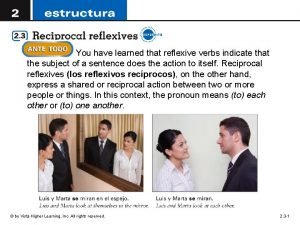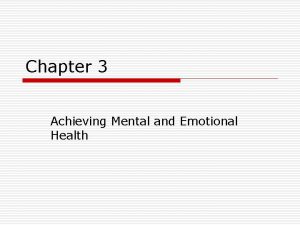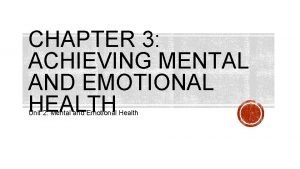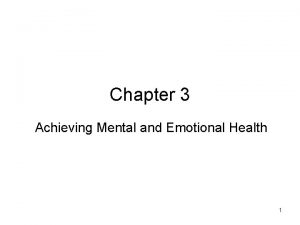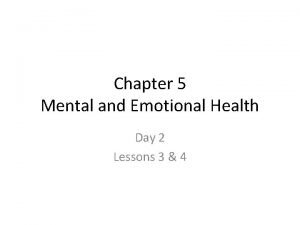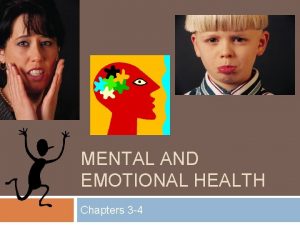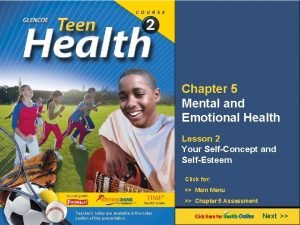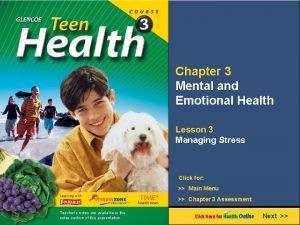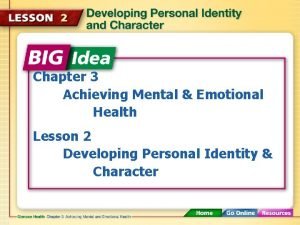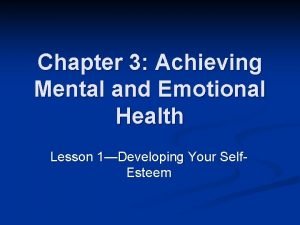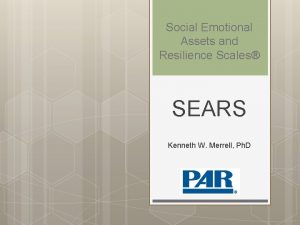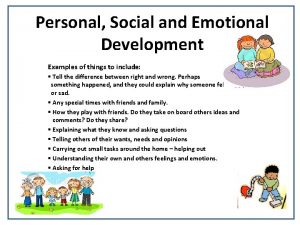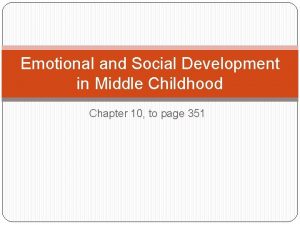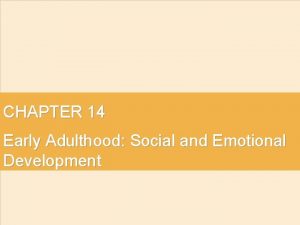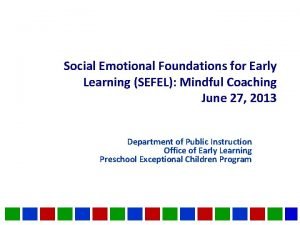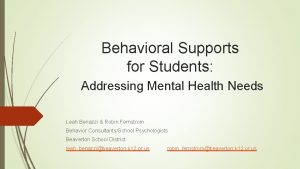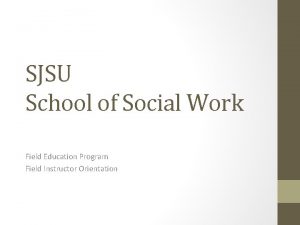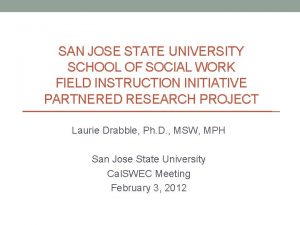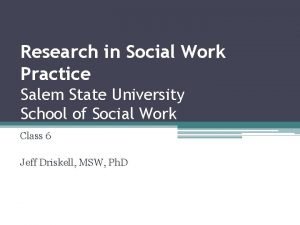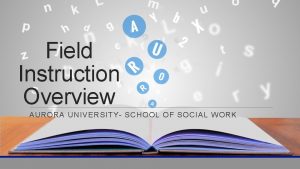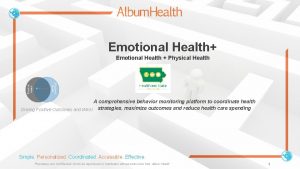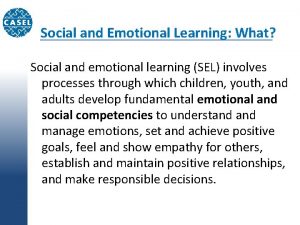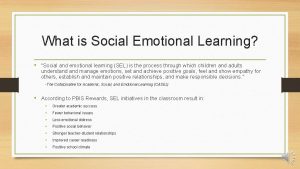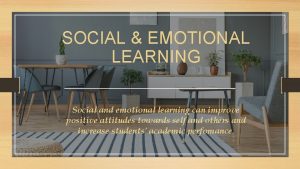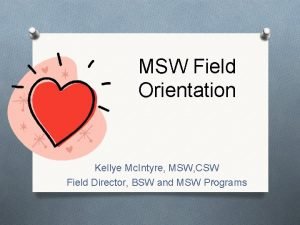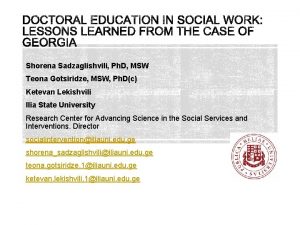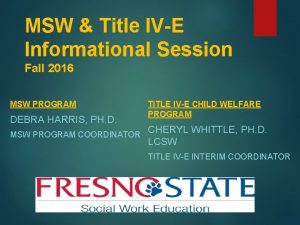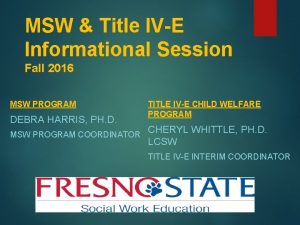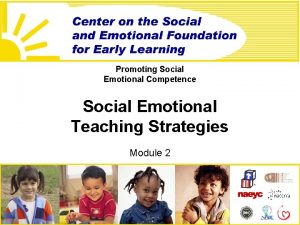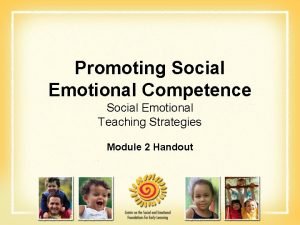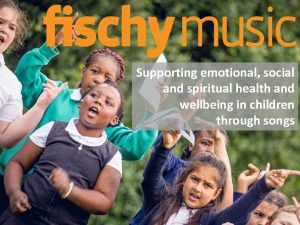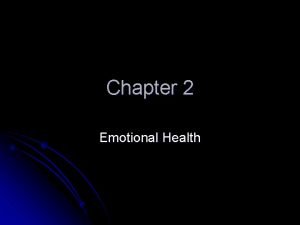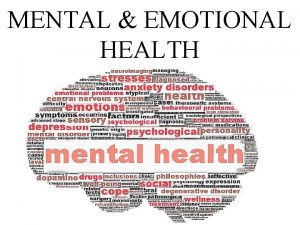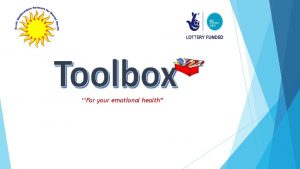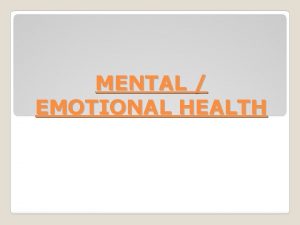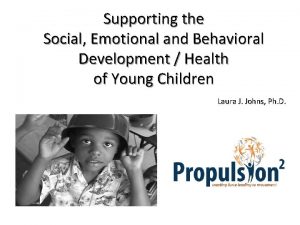Supporting Social and Emotional Health Laura Fefchak MSW








































- Slides: 40

Supporting Social and Emotional Health Laura Fefchak, MSW, LISW Social Work Services Coordinator Des Moines Public Schools

We will be talking about… �Social and emotional health �Children’s mental health and academic outcomes �Risk and protective factors �Critical components of a whole school approach

What do we mean by social and emotional health? �Emotional well-being ◦ such as perceived life satisfaction, happiness, cheerfulness, peacefulness. �Psychological well-being ◦ such as self-acceptance, personal growth including openness to new experiences, optimism, hopefulness, purpose in life, control of one’s environment, spirituality, self-direction, and positive relationships. �Social well-being ◦ social acceptance, beliefs in the potential of people and society as a whole, personal self-worth and usefulness to society, sense of community. CDC, 2015

Emotional/mental health is… More than the absence of illness; It includes the possession of skills necessary to cope with life’s challenges

Why does it matter? �Healthy learners are less likely to engage in problem behaviors that interfere with learning (Wang, Haertel, & Walberg, 1997) �Students who can manage their emotions are more able to focus on learning as anxiety reduces the working memory that is necessary for most learning

Why does it matter? Failure to pay attention to the emotional health of students is linked to: �Poor academic performance �Behavior problems �School violence �Dropping out of school �Substance abuse �Special Education referrals �Suicide �Criminal activity (Whelley, Cash, Bryson, 2003)

This is serious stuff… who do we work with? “Parents and other caregivers are the child’s first and foremost teachers. Prevention programs that address issues of parents and other caregivers increase the potential for positive outcomes. ” (SAMHSA, 2007)

This is serious stuff… who do we work with? Mental health resides not only within the child, but also within the influential web of interactions surrounding the child. This includes: *Family * School * Neighborhood

Risk Factors Individual characteristics or peer, family, community/societal conditions that have been shown by research to increase the likelihood of problem behavior: Poverty Being a victim of abuse Poor social skills Reading disability Exposed to inconsistent or harsh discipline practices

Protective Factors Are individual characteristics or peer, family, community or societal conditions that have been shown by research to reduce the impact of risk factors and/or decrease the likelihood of problem behavior and promote positive emotional health. Strong connection to school Possessing conflict management skills Meaningful relationships with adults

Building Protective Factors �A sense of belonging �Accomplishment �Adapting to change �Recognition �Making a difference �Resiliency (Whelley, Cash, Bryson, 2003)

Sense of Belonging Turn to your table partner and ask how your building creates a sense of belonging

Sense of Belonging �Building a connection to the school �Establishing �Create trust with parents a welcoming environment

Sense of Belonging School connectedness is: “the belief held by the students that the adults and peers in the school care about their learning as well as about them as individuals” (CDC, 2009)

Sense of Belonging �Engaging families means that parents are regarded as the expert about their child �Parents are seen as integral to the school community �Consider: representation on school wide leadership teams and parent trainings on issues of importance to

Sense of Belonging �Creating a welcoming environment which includes: ◦ Caring and supportive relationships ◦ Shared positive norms, goals and values ◦ Clear routines ◦ Clear behavioral expectations ◦ Fair consequences

Sense of Accomplishment �Important for students to know that they can accomplish goals through their own actions �This requires that we help students set their own goals

Adapting to Change �Adapting to change is a critical capacity �Some students react very negatively to change, especially if they are experiencing emotional stress �We can minimize difficulties by giving advance warning when things are different and allowing them to take part in the change

Recognition �Positive feedback that is specific and meaningful �Devise situations where students will be successful and then offer praise �Even if the student is in trouble, try to start with something supportive/positive

Recognition �This is an important component of Tier 1 and crucial that all staff are engaging in acknowledging appropriate behaviors �This requires acknowledgement systems to be easy and simple for both students and staff

Making A Difference �All students benefit when they know they can make a difference �Create a variety of developmentally appropriate opportunities for students to help �After school activities, service learning and community projects are ways to support this protective factor

What is resiliency? https: //www. youtube. com/watch? v=cq. O 7 Yo. Mscc. U

Resiliency �It is the ability to bounce back from defeat by resetting one’s compass, redefining goals, and continuing on the course �We can act as encouragers to students

Addressing Mental Health Challenges �Building protective factors into the learning environment gives most students the sturdy foundation they need for learning �However, we know that sometimes there are more serious social/emotional concerns that we need to support

What is a mental health disorder? A mental disorder or mental illness is a diagnosable illness that: * affects a person’s thinking, emotional state and behavior * disrupts the person’s ability to: - work/attend school - carry out daily activities - engage in satisfying relationships

Prevalence Rates Turn to the person next to you. What are the top three mental health disorders for youth ages 13 -18?

Prevalence Rates Anxiety – 31. 9% Behavior Disorders – 19. 1 % Mood disorders – 14. 3 % Substance use Disorders – 11. 4 % Attention Deficit Disorder – 4% Eating Disorder – 3% (Youth Mental Health First Aid, 2012)

Exercise Age of Onset Activity

Who is appropriately trained to diagnose a mental health disorder: �MD �DO �ARNP – advanced registered nurse practitioner �PA – physician’s assistant �LISW �Ph. D �LMHC/LMFT

Signs and Symptoms �Physical �Emotional �Behavioral �Thoughts/Cognitions

Physical �Pounding heart, chest pain, rapid heartbeat �Fast breathing, shortness of breath �Dry mouth, stomach pains, nausea, vomiting �Muscle aches and pains, restlessness, tremors/shaking, inability to relax �Change in hygiene/unkempt �Sleeping more/less than usual

Emotional �Depressed mood/mood swings �Unrealistic/excessive anxiety �Excessive irritability or anger �Lack of inhibition �Lack of emotional response �Hopelessness/helplessness �Oversensitivity to comments/criticism �Low self esteem

Thoughts �Frequent self-criticism/self-blame �Pessimism �Difficulty concentrating/remembering �Rigid thinking/racing thoughts �Delusions/hallucinations �Suspiciousness �Thoughts of death/suicide

Behavior �Crying spells �Withdrawing from others �Neglect of responsibilities �Loss of motivation �Slow movement �Use of drugs/alcohol �Changes in energy level �Obsessive/compulsive behavior �Showing distress

How do I know if I should be concerned? �Examine the impact of the change ◦ Are they struggling… �In school? �In social settings? �In daily activities? Symptoms of a mental illness can often appear similar to typical development during the period of adolescence

Addressing Mental Health Challenges �Know the signs �Access appropriate supports �Reiterate that teachers are not mental health professionals �Develop procedures for dealing with concerning situations including a crisis plan (Whelly, Cash, & Bryson, 2003)

Assessing for Suicide �Ask the question: are you thinking of killing yourself? �Is there a plan? Higher level of planning means higher risk ◦ Have you decided how you would kill yourself? ◦ Have you decided when you would do it? ◦ Have you taken any steps to secure things you need to carry out your plan? A lower level of planning does not mean there is no risk

Resources: National Suicide Prevention Lifeline: 1 -800 -273 -TALK Available 24/7 Broadlawns Crisis Team (24 hours) 515 -282 -5752 Know your building’s procedures when there is a concern regarding student safety

Want to learn more?

Resources Centers for Disease Control and Prevention (2013). Mental Health Basics. Retrieved from : http: //www. cdc. gov/mentalhealth/basics. htm Wang, M. C. , Haertel, G. D. , & Walberg, H. J. (1997). Fostering educational resilience in inner-city schools. Children and Youth, 7, 119– 140. Whelley, Peter, Cash, Gene, and Bryson, Dixie (2003). The ABCs of Children’s Mental Health. Retrieved from: http: //www. nasponline. org/resources/handouts/abcs_handout. p df Youth Mental Health First Aid Manual (2012).
 Laura conocía bien a elián. elián conocía bien a laura.
Laura conocía bien a elián. elián conocía bien a laura. Health and social care component 3
Health and social care component 3 Chapter 3 achieving mental and emotional health answer key
Chapter 3 achieving mental and emotional health answer key Emotional health and wellbeing framework
Emotional health and wellbeing framework Chapter 3 achieving mental and emotional health
Chapter 3 achieving mental and emotional health Chapter 3 mental and emotional health
Chapter 3 mental and emotional health Glencoe health chapter 5 mental and emotional problems
Glencoe health chapter 5 mental and emotional problems Chapter 5 lesson 4 getting help
Chapter 5 lesson 4 getting help Chapter 3 achieving mental and emotional health answer key
Chapter 3 achieving mental and emotional health answer key Chapter 3 achieving mental and emotional health
Chapter 3 achieving mental and emotional health Chapter 15 achieving mental and emotional health answer key
Chapter 15 achieving mental and emotional health answer key Achieving mental and emotional health
Achieving mental and emotional health Chapter 3 mental and emotional health
Chapter 3 mental and emotional health Chapter 3 achieving mental and emotional health
Chapter 3 achieving mental and emotional health Chapter 3 achieving mental and emotional health
Chapter 3 achieving mental and emotional health Lesson 2 developing personal identity and character
Lesson 2 developing personal identity and character Chapter 3 achieving mental and emotional health
Chapter 3 achieving mental and emotional health Chapter 15 achieving mental and emotional health
Chapter 15 achieving mental and emotional health Sears rating scale
Sears rating scale Fictional character names
Fictional character names Social development in middle childhood
Social development in middle childhood Emotional changes in middle adulthood
Emotional changes in middle adulthood Emotional development during early adulthood
Emotional development during early adulthood Sefel training
Sefel training Emotional development in late adulthood
Emotional development in late adulthood Emotional health examples
Emotional health examples Example of emotional health
Example of emotional health Mental emotional health
Mental emotional health Social thinking adalah
Social thinking adalah Social thinking social influence social relations
Social thinking social influence social relations Hendrefoelan student village
Hendrefoelan student village Sjsu msw
Sjsu msw Msw vtmis
Msw vtmis Msw apes
Msw apes Sjsu social work
Sjsu social work Salem state msw
Salem state msw L l logo
L l logo Aurora university msw
Aurora university msw Fau msw program
Fau msw program Tk20 uwf
Tk20 uwf University of texas arlington msw
University of texas arlington msw
